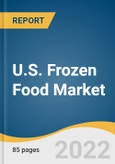Major food manufacturers have been ramping up their production capacity due to increased demand for frozen foods among consumers owing to safety and hygiene concerns. These products are packed well in containers, boxes, and bags hence making them a safe option for consumption. According to an article published in Food Dive, April 2020, four categories of frozen food section witnessed unprecedented growth including frozen meat (101%), frozen snacks (82.3%), and frozen beverages (94.6%) due to their convenience to cook as most of the restaurants were shut down during the pandemic due to safety protocols in the country.
Ready meals held the largest segment in 2021 and are expected to maintain dominance during the forecast period. The frozen ready meal is often consumed with little or no further processing except reheating, hence convenient to cook. Furthermore, these products are also high in nutritional value and flavor, since crops are harvested at the height of freshness and frozen quickly to seal in nutrients and taste. According to Food Dive April 2020, 7 out of 10 consumers in the country are buying more frozen ready-made food including meal bowls, and pizza.
The offline segment contributed a majority of the share to become a larger division in the global revenue in 2021. Many offline stores including convenience stores and supermarkets have freezing and temperature-controlled facilities, which is driving the growth of offline distribution channels. Additionally, the increasing penetration of independent retail giants such as Wal-Mart, and Costco among others, is boosting product visibility and attracting a larger consumer base. For instance, Banquet, a frozen food brand is all seasons available at Wal-Mart in the U.S. The U.S. frozen food market is highly fragmented with the presence of a large number of regional and local players.
U.S. Frozen Food Market Report Highlights
- Frozen baked products are projected to register the fastest growth due to their high nutritional value, all-season availability, and competitive pricing. These are the factors credited for this growth.
- Online channel is anticipated to register the fastest growth during the forecast years owing to promising growth exhibited by e-commerce platforms, including Amazon, Wal-Mart, and other such service providers.
Table of Contents
Companies Mentioned
- Cargill, Incorporated
- Nestlé S.A.
- Kraft Heinz Company
- General Mills, Inc.
- Conagra Foods, Inc.
- Ajinomoto Co. Inc
- Mccain Foods
- Nomad Foods Ltd
- Bellisio Foods
- Wawona Frozen Foods
Table Information
| Report Attribute | Details |
|---|---|
| No. of Pages | 85 |
| Published | April 2022 |
| Forecast Period | 2022 - 2030 |
| Estimated Market Value ( USD | $ 55.08 Billion |
| Forecasted Market Value ( USD | $ 84.58 Billion |
| Compound Annual Growth Rate | 4.7% |
| Regions Covered | United States |
| No. of Companies Mentioned | 10 |









